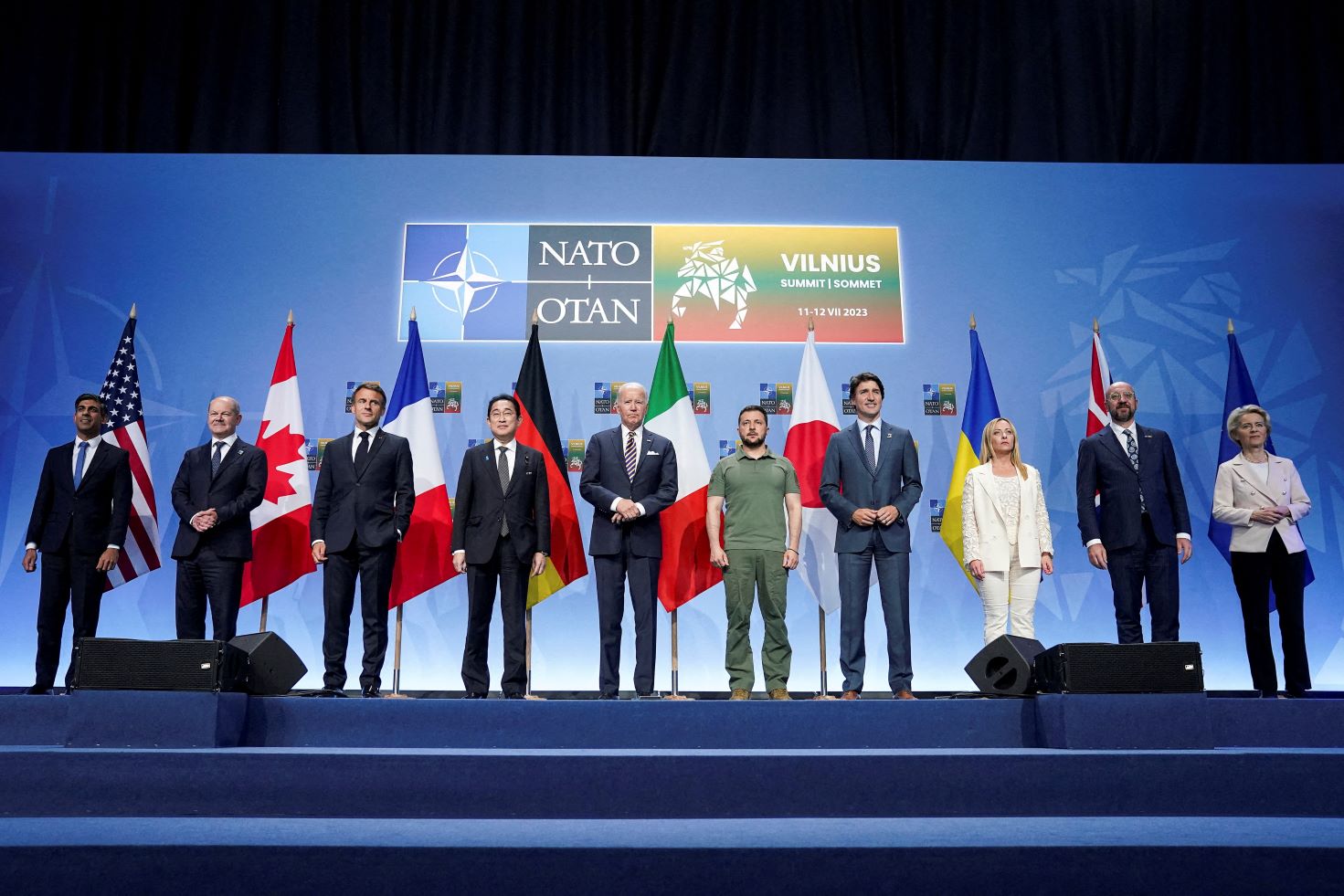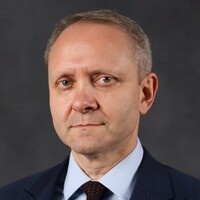Leaders of the North Atlantic Treaty Organization (NATO) gathered in Vilnius, Lithuania, on July 11–12 to discuss Sweden’s accession, Ukraine membership, new regional defense plans, and other global challenges. Despite significant successes, fundamental divisions within NATO and with wartorn Ukraine were evident. Council of Councils (CoC) experts react to the NATO and Group of Seven (G7) commitments made at the summit for this CoC global perspective series, and what they portend for the future of the alliance.

Realism Was the Right Approach in Vilnius
Realism is the hallmark of the latest NATO summit. The deal reached by Turkish President Recep Tayyip Erdoğan, Swedish Prime Minister Ulf Kristersson, and NATO Secretary General Jens Stoltenberg in Vilnius paves the way to finalize Sweden’s accession to NATO by the end of 2023—an historic landmark for the alliance.
A realist approach was also adopted on the future of Ukraine’s path toward NATO membership, resulting in a compromise between different views within the alliance. On the one hand, Poland, the Baltic states, and other east European members strongly argued in favor of a precise accession timeline as requested by Kyiv. On the other hand, the United States and most Western Europe did not want to admit a country which may still be at war with Russia for years in the Atlantic alliance because it would trigger NATO article 5 on collective defense. The final communique restated the ultimate goal was for Ukraine accession, but postponed the decision to invite them to join NATO sine die, only indicating the vague formula of “when Allies agree and conditions are met.”
The harsh reality is that Kyiv’s NATO membership will mostly depend on the fate of the ongoing counteroffensive as well as on its capacity to withstand a likely prosecution of the current war of attrition beyond 2023. At Vilnius, allies both reconfirmed their strong commitment to militarily support Kyiv “for as long as it takes” and stepped up supplies of weapons and equipment. Simultaneously, NATO enhanced its deterrence and defense posture with updated geographic regional plans, large high-readiness forces, and robust exercises to be run on the eastern flank. As a whole, the summit delivered a message of allied unity on the approach adopted since February 2022: to support Ukraine as much as possible without entering a direct war with Russia. It is a realist, long-term balancing act that, though disappointing to Kyiv, enables an unprecedented level of allied military aid for a non-NATO member.
Although much of the summit focused on the Russian threat and support to Ukraine, the attendance of leaders of Australia, Japan, New Zealand, and South Korea is noteworthy. NATO is increasingly interested in partnering with those like-minded countries because of not only the U.S .aim to contain and counter China, but also the greater awareness of European allies—particularly Italy and the United Kingdom—that the security of the Euro-Atlantic and Indo-Pacific regions are closely interconnected.
Bilateral Security Commitments Cannot Replace NATO Membership
In Vilnius, NATO made an important decision to approve defense plans in line with a new strategy agreed to at last year’s summit. The plans will enable the defense of the alliance against potential large-scale Russian aggression launched even without warning. These plans will now need to be augmented with more—some three hundred thousand troops—and better-equipped forces maintained at a high level of readiness. To facilitate necessary investments, NATO also approved a new defense pledge, which states that the allies will invest at least 2 percent of GDP in defense annually, replacing the previous 2014 commitment to aim to move toward spending 2 percent within a decade. The development of robust forces ready to fight a high-intensity war with Russia will be a challenge for numerous allies. Some still do not believe that Russia could realistically attack NATO, even if it rebuilds its forces weakened by the invasion of Ukraine. If the necessary investments are not made, however, NATO’s credibility risks being questioned and Russia could underestimate the determination of the alliance to defend itself.
NATO also adopted a package of decisions, which should enable sustained military support for Ukraine but are still flawed. The allies did not agree to invite Ukraine to join NATO and demonstrate that Ukraine’s status would not become a subject of peace talks between major Western powers and Russia. The alliance agreed only to waive the requirement for a membership action plan, potentially shortening the future process of accession. Nevertheless, Ukraine will still need to implement democratic and security sector reforms. The United States and other allies argued that anything more specific would only encourage Russia to prolong the war. Some NATO members were also concerned that formal commitments to Ukraine could speed up its membership before the war ends, drawing the alliance into direct confrontation with Russia.
Although such arguments sound convincing, it is clear that no consensus has been reached on whether Ukraine should join the alliance in the foreseeable future at all. The Biden administration has not worked out such strategic decisions even though bipartisan consensus in the U.S. Senate is a precondition of ratifying NATO enlargement. In addition, Germany, which the Biden administration perceives as an indispensable ally in building a European security architecture, seems to believe that Ukraine’s membership would completely alienate Russia. Instead of NATO commitments, the Group of Seven countries offered bilateral security assurances for Ukraine, including the promise of increased military support in the event of future Russian aggression. However, such guarantees risk becoming permanent. The United States can hide behind Germany’s objections to avoid making politically difficult decisions on Ukraine’s accession to NATO. Meanwhile, Germany can do the same indicating that the United States should first make the decision. This will be a challenge for Ukraine and its partners, such as Poland, to convince U.S. decision-makers that NATO membership is much less costly and risky than bilateral security guarantees, which may encourage Russia to test their credibility.
A More Uncertain and Perilous Cold War Model
The NATO summit in Vilnius confirmed the transition of relations between Russia and the alliance to the Cold War model in its most severe form. Today, however, is significantly different. Then the confrontation in Europe was based on certain rules of conduct and a clear understanding of the spheres of influence. Protection of those spheres was the essence of the confrontational relationship. NATOs mission was to defend the values of the free world in the face of Soviet expansionism. Nuclear deterrence and ideological parity created conditions in which the alliance never conducted military operations in the Cold War’s forty years. After the Cold War, however, NATO became an organization not only to defend, but also to promote its values in different ways—military actions in several parts of the world (such as Yugoslavia, Afghanistan, and Libya) and political and diplomatic activities in the European part of Eurasia. That is, the nature of the organization has seen a qualitative change.
U.S. President Joe Biden announced in Vilnius that the West was ready for a long-term confrontation with Russia, as long as it takes, in other words, the Cold War model. Simultaneously, Ukraine’s desire to receive an invitation to NATO has not yet been satisfied. That is, the conflict in Ukraine is reminiscent of the sharp collisions of the Cold War that unfolded far from Europe—in Afghanistan, Korea, and Vietnam—an indirect but obvious clash between Moscow and Washington. Now this is happening in the center of Europe, and thus there is a high risk of a direct standoff. This is a new reality that did not exist in the second half of the twentieth century. The confrontation, judging by all signs, will be long term. Russia is also preparing for that.
However, a new geopolitical status quo is needed to make confrontation more or less safe. Russia considers post–Cold War NATO to be an expansionist bloc and sees the challenge in stopping such expansion. NATO sees Russia as a revanchist and revisionist power but is unclear yet about the limits the alliance is ready to overstep in efforts to stop it. The summit in Vilnius confirmed the views of both sides but did not indicate any path toward a sustainable and manageable conflict.









